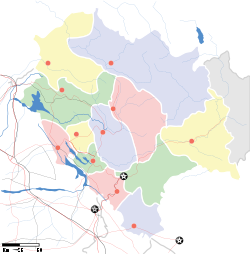- Nurpur, India
-
Nurpur — city — Coordinates 32°18′N 75°54′E / 32.3°N 75.9°ECoordinates: 32°18′N 75°54′E / 32.3°N 75.9°E Country India State Himachal Pradesh District(s) Kangra Population 9,066(17th) (2005[update]) Time zone IST (UTC+05:30) Area
• 643 metres (2,110 ft)
Nurpur is a city and a municipal council in Kangra district in the Indian state of Himachal Pradesh. It was formerly a Kingdom ruled by the Pathania clan of Rajputs, since the 11th century AD. The capital of the Kingdom was at Pathankot, now in Punjab.
Contents
Geography
Nurpur is located at 32°18′N 75°54′E / 32.3°N 75.9°E.[1] It has an average elevation of 643 metres (2109 feet).
Demographics
As of 2001[update], according to the India census,[2] Nurpur had a population of 9045. Men constitute 52% of the population and women 48%. Nurpur has an average literacy rate of 78%, higher than the national average of 59.5%: male literacy is 81%, and female literacy is 75%. In Nurpur, 11% of the population is under 6 years of age.
History
Before 1947, Nurpur was a princely state ruled by the Pathania clan of Rajputs. The Pathania Clan (or Tomar /Tanwar clan of Chandravanshi Rajputs) had ruled here for more than eight centuries.
Nurpur was known as Dhameri until a visit from Noorjehan, the Queen of Emperor Nuruddin Salim Jahangir (1569–1627) of the Mughal Dynasty. The queen was so impressed by the natural beauty of the town, that she decided to construct her palace here. This posed a problem for then local ruler Raja Jagat Singh Pathania he did not want his freedom to be curtailed by the Mughal domination and politics. So, he perpetrated the story that the climate of the place was not good and caused a disease Goiter, which was at that time very common among locals. Horrified, the queen dropped the idea of constructing her palace, but the name of the town was changed to Nurpur in 1622, by the Raja Jagat Singh Pathania to commemorate this visit of Begum Nur Jahan who had instantly fallen in love with this place.
Economy
Nurpur is known for its orchards, which grow crops of mango, oranges, leechi and amla. Nurpur is also noted for poultry farming. Nurpur is also famous for silk and pashmina shawls.
Places of interest
The Brij Raj Swami temple inside the Nurpur fort is a 16th century historical temple of Lord Krishna and home to a much revered deity of the local population and attracts tourists. It is the only temple in the world, where Lord Krishna and Meera idols are worshipped. It is said the statue of Lord Krishna was worshipped by Meera, and when Raja of Nurpur went to Chittorgarh he got this statue as a return gift from the Maharana of Chittorgarh. Along with this, Raja also brought a Moulsary (a fruit-bearing plant) sampling and it was dried on way back and it was put to life through Puja and chanting of mantras. This plant has now grown into a huge tree. It flowers, but does not bear any fruit unlike such plants in Rajasthan. The Nagni Maata temple, located about 6 km from Nurpur town on Pathankot/Kullu highway, is also very famous. It is unique because water comes from below the temple where the idol of Naagni Maata is placed. People who get snake bite, come to Naagni Maata and simply drinking water and applying the Mitti, get cured completely. The amount of water which flows there is quite sufficient, and there are number of water mills installed for grinding grain.
The Nurpur fort is the main attraction of this small town. Originally built before the 10th century, it was the main seat of the Pathania Kings. It was destroyed partially by the British and the great earthquake which hit this region in April 1905 AD. Most of the fortress is in ruins, but it is still worth visiting.
References
- ^ Falling Rain Genomics, Inc - Nurpur
- ^ "Census of India 2001: Data from the 2001 Census, including cities, villages and towns (Provisional)". Census Commission of India. Archived from the original on 2004-06-16. http://web.archive.org/web/20040616075334/http://www.censusindia.net/results/town.php?stad=A&state5=999. Retrieved 2008-11-01.
Further reading
- Hutchinson, J. & J. PH Vogel (1933). History of the Panjab Hill States, Vol. I. 1st edition: Govt. Printing, Pujab, Lahore, 1933. Reprint 2000. Department of Language and Culture, Himachal Pradesh. Chapter VI Nurpur State, pp. 213–267.
Categories:- Cities and towns in Kangra district
Wikimedia Foundation. 2010.


